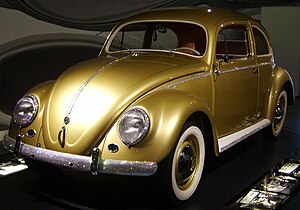
Back المعجزة الاقتصادية الألمانية Arabic Германско икономическо чудо Bulgarian Německý hospodářský zázrak Czech Wirtschaftswunder Danish Wirtschaftswunder German Milagro económico alemán Spanish Wirtschaftswunder Basque معجزه اقتصادی آلمان Persian Länsi-Saksan talousihme Finnish Wirtschaftswunder French

The Wirtschaftswunder (German: [ˈvɪʁt.ʃaftsˌvʊndɐ] ⓘ, "economic miracle"), also known as the Miracle on the Rhine, was the rapid reconstruction and development of the economies of West Germany and Austria after World War II (adopting an ordoliberalism-based social market economy). The expression referring to this phenomenon was first used by The Times in 1950.[2]
Beginning with the replacement of the Reichsmark with the Deutsche Mark in 1948 as legal tender (the Schilling was similarly re-established in Austria), a lasting era of low inflation and rapid industrial growth was overseen by the government led by West German Chancellor Konrad Adenauer and his Minister of Economics, Ludwig Erhard, who went down in history as the "father of the West German economic miracle." In Austria, efficient labor practices led to a similar period of economic growth.
The era of economic growth raised West Germany and Austria from total wartime devastation to developed nations in modern Europe. At the founding of the European Common Market in 1957 West Germany's economic growth stood in contrast to the struggling conditions at the time in the United Kingdom.
- ^ Rieger, Bernhard (2009-09-01). "The 'Good German' Goes Global: the Volkswagen Beetle as an Icon in the Federal Republic". History Workshop Journal. 68 (1): 3–26. doi:10.1093/hwj/dbp010. ISSN 1363-3554.
- ^ "Wirtschaftswunder, n." Oxford English Dictionary Online. September 2009. Archived from the original on May 2, 2022. Retrieved 16 October 2014.
© MMXXIII Rich X Search. We shall prevail. All rights reserved. Rich X Search